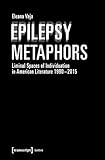Epilepsy Metaphors : Liminal Spaces of Individuation in American Literature 1990-2015 / Eleana Vaja.
Material type: TextSeries: LettrePublisher: Bielefeld : transcript Verlag, [2017]Copyright date: 2017Description: 1 online resource (256 p.)Content type:
TextSeries: LettrePublisher: Bielefeld : transcript Verlag, [2017]Copyright date: 2017Description: 1 online resource (256 p.)Content type: - 9783839441183
- American literature -- 20th century -- History and criticism
- American literature -- 21st century -- History and criticism
- Epilepsy in literature
- Individuation (Psychology) in literature
- American Studies
- Body
- Conceptual Metaphors
- Disability Studies
- Literary Studies
- Literature
- Medicine
- Metastability
- Normativity
- Siri Hustvedt
- LITERARY CRITICISM / American / General
- American Studies
- Body
- Conceptual Metaphors
- Disability Studies
- Literary Studies
- Literature
- Medicine
- Metastability
- Normativity
- Siri Hustvedt
- 810.90054 23
- PS225 .V35 2017
- online - DeGruyter
| Item type | Current library | Call number | URL | Status | Notes | Barcode | |
|---|---|---|---|---|---|---|---|
 eBook
eBook
|
Biblioteca "Angelicum" Pont. Univ. S.Tommaso d'Aquino Nuvola online | online - DeGruyter (Browse shelf(Opens below)) | Online access | Not for loan (Accesso limitato) | Accesso per gli utenti autorizzati / Access for authorized users | (dgr)9783839441183 |
Frontmatter -- Contents -- Acknowledgments -- Introduction -- I. The Folklore of Epilepsy -- I.A Falling Asleep: The Stigma of Epilepsy in History -- I.B American Literature: From Stigma to Metaphor? -- I.C Ableist Metaphors: Historical Motifs and Normalcy -- II. Liminal Spaces of Individuation -- II.A Jürgen Link and Michel Foucault: Symptomatic Signification of Proto- and Flexmetaphors -- II.B George Canguilhem: Vital Materiality and Relational Metaphors -- II.C Gilbert Simondon: Transindividual Metastability and Conceptual Metaphors -- III. Epilepsy Metaphors in American Literature (1990–2015) -- III.A Metaphor and Society: Proto- and Flexmetaphors and Calculated Individuation -- III.B Metaphor and Materiality: The Relational Body and Its Electric Individuation -- III.C Metaphor and Idioms: Siri Hustvedt’s Metastable Rhetoric as Transindividuation -- Conclusion -- Bibliography
restricted access online access with authorization star
http://purl.org/coar/access_right/c_16ec
Between 1990 and 2015, American literature saw the emergence of a new corpus of epilepsy metaphors which tackle the stigma of epilepsy within three areas: society, body, and language. Eleana Vaja introduces concepts such as protometaphors, relational metaphors, epileptic texts, and metastability to categorize and examine these foci further. Applying philosophy as well as "hard sciences" (i.e. mathematics, medicine, physics) to disability studies, her study of selected works by Siri Hustvedt, Thom Jones, Reif Larsen, Dennis Mahagin, Audrey Niffenegger, Rodman Philbrick, and Lauren Slater shows how epilepsy metaphors redefine the notion of the "liminal" and the "normal".
Mode of access: Internet via World Wide Web.
In English.
Description based on online resource; title from PDF title page (publisher's Web site, viewed 26. Aug 2024)


